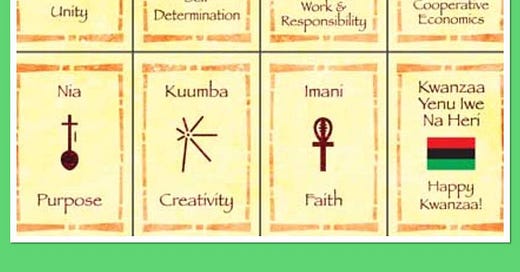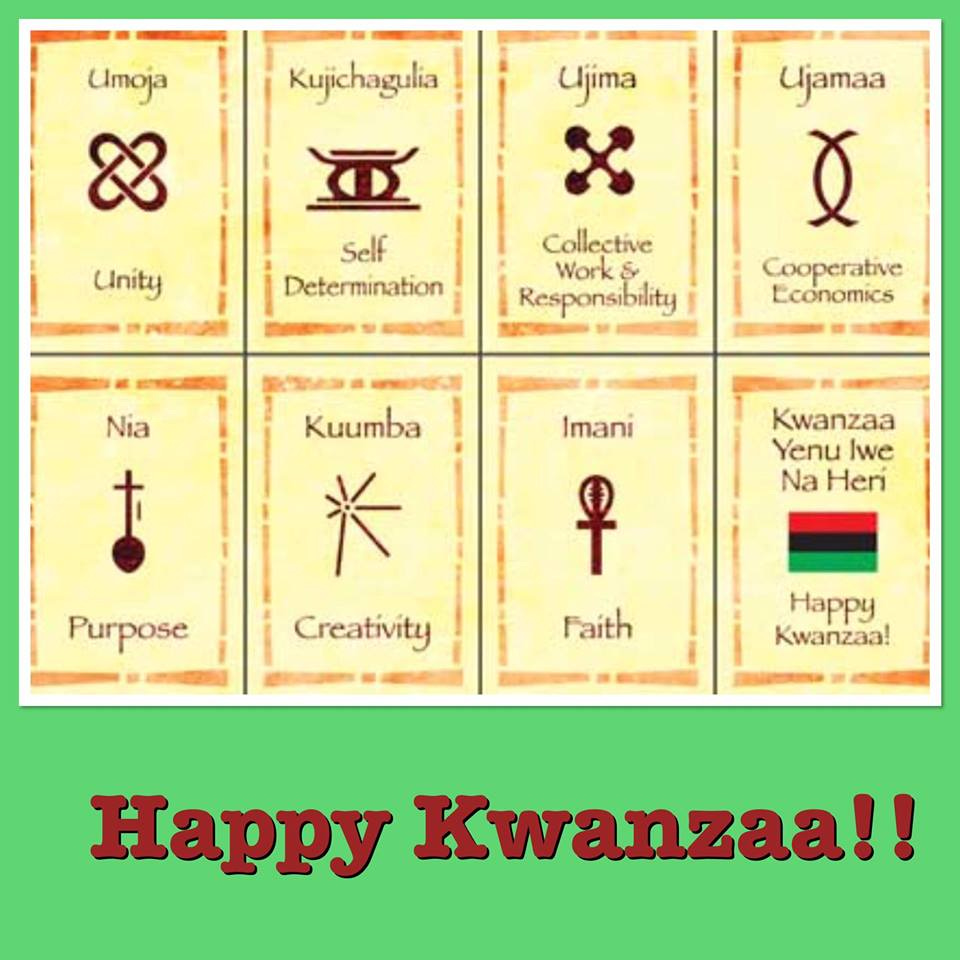Kwanzaa: A Celebration of Family, Community, and Culture
An African American and African Diaspora Cultural Holiday
Issue #205 Friday Funday December 23, 2022
Kwanzaa is a Pan-African holiday created in 1966 by Dr. Maulana Karenga, a professor of Africana Studies at California State University, Long Beach. Kwanzaa is a community- and family-based cultural holiday celebrated annually over 7 days from December 26 through January 1. Kwanzaa merges African-American and African cultural practices and is now celebrated all over the world. Kwanzaa is meant to be celebrated with family gatherings and also with community festivals of all sizes. Kwanzaa is not a religious holiday, nor should it be considered a “Black Christmas.” The name “Kwanzaa” is derived from the Kiswahili phrase, “matunda ya kwanza,” which means “first fruits.” Kiswahili is the most widely spoken African language. Kwanzaa is specifically designed to represent the beauty, integrity, dignity, and affirmation of people of African descent and the shared cultural community of the African Diaspora. All in the community are invited to celebrate Kwanzaa and reflect on the values.
Today’s post continues below.
No intrusive ads or annoying popups ever! Instead, please see the important information below and at the bottom of this post. That’s how we grow and sustain this publication. AND, please keep those “Likes” and comments coming! Thanks!
Paid subscribers with the Substack app are invited to participate in the W.A.S. Chat Room to discuss today’s post.
All posts are free for ten days after their publication. To read all older posts, including the complete archive, and to support us financially, please consider upgrading your subscription to a paid level. Save 17% with an annual subscription. Thank you for your support!
The Seven Principles of Kwanzaa
The celebration of Kwanzaa is based on the value set of the African philosophical framework of Kawaida and is centered around the Seven Principles of Kwanzaa, known as the Nguzo Saba or Seven Principles in Kiswahili. One principle is highlighted on each of the seven days of Kwanzaa. People are encouraged to memorize the Kiswahili naming of the seven principles and the meaning of each principle, as well as to live out the principles all during the following year.
Umoja-Unity To strive for and maintain unity in the family, community, nation, and race.
Kujichagulia-Self-Determination To define ourselves, name ourselves, create for ourselves, and speak for ourselves.
Ujima-Collective Work and Responsibility To build and maintain our community together and make our brothers’ and sisters’ problems our problems and to solve them together.
Ujamaa-Cooperative Economics To build and maintain our own stores, shops, and other businesses and to profit from them together.
Nia-Purpose To make our collective vocation the building and developing of our community in order to restore our people to their traditional greatness.
Kuumba-Creativity To do always as much as we can, in the way we can, in order to leave our community more beautiful and beneficial than we inherited it.
Imani-Faith To believe with all our heart in our people, our parents, our teachers, our leaders, and the righteousness and victory of our struggle.
The Nguzo Saba are the heart of the origin and meaning of Kwanzaa and the embodiment of the values which are the building blocks for the community and meant to reinforce and enhance those values.
How Kwanzaa is Celebrated
Kwanzaa is designed to be celebrated by family units at home and/or at events sponsored by community organizations. On each of the seven days of Kwanzaa, people greet each other by asking: “Habara Gani?” in Kiswahili which means, “What’s the news?” The response is the Kwanzaa principle of the day. For example, on Day Three, when you are greeted by Habara Gani? you answer, Ujima!
Wherever the celebration is located, a special Kwanzaa table is set up in a central place incorporating the seven basic symbols and two supplemental symbols. The leader of the day’s celebration reminds the gathering of the values of Kwanzaa and the day’s principle and then pours libations to honor the ancestors. One of the seven candles representing each principle is lit. There is usually African dancing, drumming, and a storytelling session by an elder or a griot. Small gifts, preferably handmade, are given to the children and the elders, and then a meal is shared. The celebration and decorations can be simple or elaborate but should adhere to the African culture and values of Kwanzaa. Ideally, the decorations are hand-made by an artisan of African descent or imported from Africa and purchased locally.
The colors of Kwanzaa (and of the Black Liberation Flag designed by Marcus Garvey in 1920) are black (for the African people), red (for the bloodshed during the struggle), and green (for the land and for hope for the future). A beautiful piece of African cloth is spread on the table.
Mkeka: Woven straw mat representing our foundation; holds the other symbols
Kinara: The candleholder
Mishumaa Saba: The seven candles: one black, 3 red, and 3 green. The black candle is lit on the first day, and the red and green candles are alternately lit on the remaining days.
Mazao: The crops produced by collective labor
Muhindi: Ears of corn to represent the children of the family/village
Kikombe: cha Umoja: The Unity Cup; also used to pour libations
Zawadi: The gifts
Hanging on the wall near the table:
Bendera: The red, black, and green Pan-African flag.
The Nguzo Saba Poster illustrates the Kwanzaa symbols.
Because Kwanzaa spans 7 days, usually family groups or a group of friends take turns having one day’s celebration in their homes, or different community organizations each take a day to sponsor a Kwanzaa principle. On January 1, the last day of Kwanzaa (Imani-Faith), a large family or community meal is served to honor the total celebration values and to bring in the new year.
Help us to grow our We Are Speaking Substack!
Don’t Forget! If you have the W.A.S. app for iOS and Android, you can listen to each article by clicking the little headset icon. You can also participate in the W.A.S. Chat (for paid subscribers only).
Paid Subscribers: Join us in the new W.A.S. Chat!
Have you thought about starting a Substack publication of your own? It’s quick, easy, and free!
I am concentrating much more on my Instagram account. Please click the link to follow me on my ‘Gram.
I am also now on the new, left-leaning, and easy-to-use “Bird Alternative” site called POST. You can follow me there. (Your wait will be much shorter than the usual week or so with my dedicated invite below…)
You can always leave any questions in the comments, or you can email us.
Free posts are available for 10 days after publication. Adjust or upgrade your subscription to the paid level here. Pay less than 31¢ per post per month. Thank you for your financial support!





